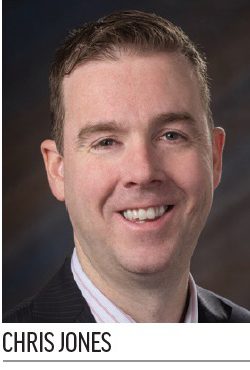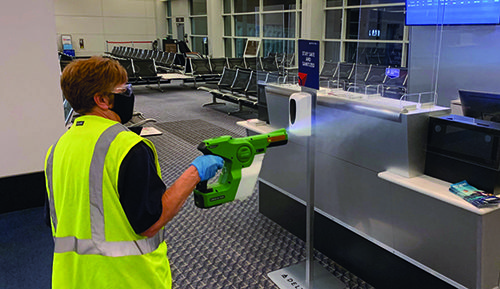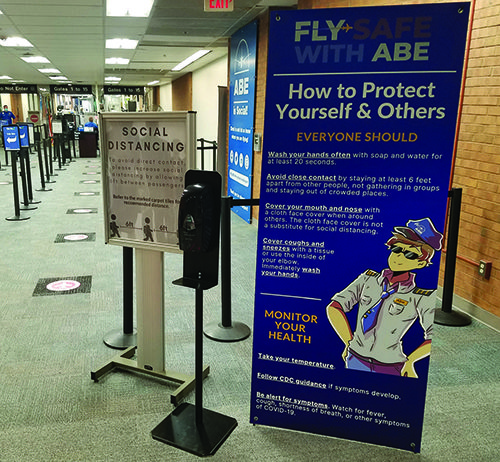With air traffic down dramatically and the future of the COVID-19 pandemic still uncertain, this has already been a trying year for the entire industry. Many airports are tackling the need for additional communication with employees and passengers by developing public awareness campaigns to emphasize the importance of social distancing, stopping the spread and other key measures.
With air traffic down dramatically and the future of the COVID-19 pandemic still uncertain, this has already been a trying year for the entire industry. Many airports are tackling the need for additional communication with employees and passengers by developing public awareness campaigns to emphasize the importance of social distancing, stopping the spread and other key measures.
Here are two examples of U.S. airports from opposite sides of the country that are executing targeted, branded marketing campaigns to help everyone in their terminals feel safe and confident to be there.
All In
|
facts&figures Project: Coronavirus-related Communication Location: McCarran Int’l Airport, Las Vegas Theme: LAS All In Creative Development: Airport’s Public Affairs & Airport Marketing Dept. Material Production: In-house Supporting Partners: Lamar Airport Advertising; Las Vegas Convention & Visitors’ Authority Cost: Nominal printing expenses Location: Lehigh Valley (PA) Int’l Airport Theme: Abe the Pilot Dual Messages: Fly Safe With Abe; Work Safe With Abe Format: A cartoon spokesman delivers tips & information to keep passengers & airport employees safe during the COVID-19 pandemic
Related Measures: |
Since the initial onset of the coronavirus crisis, McCarran International Airport (LAS) in Las Vegas has been implementing special messaging to help passengers navigate as guidelines and restrictions evolve. In April, Rosemary Vassiliadis, director of Aviation at the Clark County Department of Aviation, tasked the organization’s Public Affairs and Marketing Department with developing a themed campaign to deliver a handful of core messages regarding the COVID-19 situation.
Betting on the appeal of the area’s iconic casinos, Chief Marketing Officer Chris Jones and his team chose “LAS All In” as the unifying theme. Key messages include: “Cover Your Poker Face,” “House Rules,” “Don’t Roll the Dice: Stay Six Feet Apart,” “Bet Against the Spread” and “We’re Doubling Down on Cleaning and Sanitizing.” The red and black color scheme is based on a roulette wheel.
“We focus on thanking people for their willingness to travel and emphasize what makes us uniquely Vegas,” Jones comments. “We wanted to make it local, appropriate to our market and something the audience would respond to.”
The primary message is that LAS is “All In for Your Health and Safety.” The airport kicked off that portion of its campaign right before Memorial Day weekend to reach holiday travelers.
While gaming provided a ready theme for the airport’s campaign, it also reminded Jones and his staff about the marketing challenge they face. “We’re asking people to take a discretionary trip,” he explains. “We want them to spend money to come to Las Vegas. So we have to reassure them and let them know that we’re taking this seriously.”

Execution
When marketing personnel presented the campaign to airline personnel and internal airport groups, Jones asked various stakeholders what unique messages they wanted to convey to specific audiences such as employees, passengers, visitors, etc.
 He also made it clear that the marketing team would develop those messages for them, to ensure that they were presented in a consistent voice, design and theme. “It wouldn’t work to have everyone just throwing the logo on their own signs,” he explains. “It would diminish the effectiveness of the campaign.”
He also made it clear that the marketing team would develop those messages for them, to ensure that they were presented in a consistent voice, design and theme. “It wouldn’t work to have everyone just throwing the logo on their own signs,” he explains. “It would diminish the effectiveness of the campaign.”
Consequently, the entire campaign has been executed in-house. “There’s no added cost other than when we had things printed, which has been nominal,” Jones reports. Lamar Airport Advertising donated space on electronic displays inside the terminal that typically run paid messages from casinos, restaurants and local attractions. With air traffic nearly grinding to a halt because of the pandemic, most advertisers cancelled their orders. So Lamar opened space for the airport’s COVID-19 campaign. “With their phenomenal partnership, we really have been able to blanket the airport digitally with these ads,” says Jones. “Customers cannot help but see them.”
When Nevada’s governor announced that masks would be required in indoor public spaces, LAS’ marketing department collaborated with a longtime partner, the local visitors’ bureau. Together, they staged a promotional event in the baggage claim area, complete with showgirls passing out Vegas-branded masks.
“We’re just trying to hit consumers where we meet them, whether in person or digital, even reading in a magazine or newspaper,” Jones says.
Naturally, the team included social media in its plans. When airlines post messages on platforms such as Twitter and Instagram, LAS marketing staff share them, adding “Our partners are all in” and similar taglines. COVID-related notices from other airports get shared, too, with add-ons such as “MKE is all in.”
Jones says that it’s crucial for passengers to be comfortable with the preventive measures that both airports of their journey are taking to address coronavirus concerns.
Like its own in-terminal audio announcements and ads, the messages that LAS shares and reTweets are designed to build “social confidence” in passengers and airport staff. “We want them to feel confident in leaving their homes, going to the store, getting on a plane, staying in a hotel and also coming to the airport,” Jones explains.
It’s important to let travelers know that LAS cares about their experience from beginning to end, he emphasizes. To make that message more personal, the marketing staff recorded short videos of airport employees talking about their particular duties during the COVID-19 pandemic. One shows a bike patrol of workers wiping down everything from elevator buttons to parking payment kiosks. “One man made the comment that if his friends or family were traveling, he would want them to know this is being done,” Jones explains. “In this way, our employees also see their peers, not some director, talking to them. They are being recognized as a part of this.”
A Year to Remember
The current public awareness campaign of Lehigh Valley International Airport (ABE) in Allentown, PA, began brewing all the way back in January.
 “We were excited about the new year, with a lot of positive momentum going into a new decade,” recalls Tom Stoudt, executive director of the Lehigh-Northampton Airport Authority, which owns and operates ABE and two other local airfields.
“We were excited about the new year, with a lot of positive momentum going into a new decade,” recalls Tom Stoudt, executive director of the Lehigh-Northampton Airport Authority, which owns and operates ABE and two other local airfields.
Then coronavirus changed everything, and Stoudt realized that the Airport Authority needed to communicate a substantial amount of new information.
“As we moved further into the pandemic and a stay-at-home issue was ordered, the need for more communication only increased,” he notes.
Practicing social distancing themselves, the executive staff began convening daily calls to ensure that everyone had the latest information and the airport team’s response was evolving accordingly. “There was no manual for an airport to figure out how to work through a pandemic,” Stoudt reflects. “As so many other industries, we were learning on the fly and doing our best to respond.”

Enter Abe, a Pilot From ABE
From the very beginning, the airport’s objective was to keep people safe and healthy, and to keep staff working. Those two goals inspired Abe the Pilot, a cartoon mascot who serves as the spokesman for ABE’s dual-focus coronavirus campaign. Abe encourages passengers to Fly Safe with ABE and employees to Work Safe with Abe.
Ironically, Abe was part of a marketing initiative that was scheduled to be unveiled later this year. But when COVID-19 turned commercial air travel upside-down, the airport’s Restart Committee decided to debut him early.
“He helps communicate valuable travel information to our passengers,” Stoudt explains. “We wanted them to know that when they see Abe, he’ll have excellent advice, tips and other good information to share.”
Abe even has a backstory, which can be found online at flyabe.com/abe-the-pilot/. Although he is not based on a real person, airport employees joke that Abe and Stoudt are both Embry-Riddle alumni. “We wanted to provide important health information, but in a way that was fun, interactive, eye-catching and would stand out from the traditional regulatory and wayfinding signs one sees at an airport,” says Stoudt.
Consistency was essential to build trust with passengers and staff, he adds. The team produced all campaign materials in-house, and key executive staff members reviewed all correspondence to make sure messages had similar subject lines and were formatted to keep people paying attention.
“There was definitely a consistency in the look and feel, and how it was organized,” says Stoudt. “As people dialed in, it was easy for them to digest and navigate.”
Spokesman for Safe Practices
To understand what specific issues the airport needed to address, Stoudt walked the facility from parking lot and curb to the boarding gates and baggage claims, just as a passenger would.
“Experience what a customer will experience,” he advises fellow airport execs. “This is a new travel experience. Do your research.”
Stoudt’s own research led to modifications in ABE’s facilities and cleaning practices. Crews applied NanoSeptic® self-cleaning surface skins on high-traffic touch points such as door handles and elevator buttons. And custodians use electrostatic equipment to spray Biospada®, a long-lasting antimicrobial surface treatment/coating, onto luggage carts, wheelchairs, terminal areas, etc.
Looking ahead, the design of a future TSA checkpoint/terminal connector and the $1.7 million parking project the airport just started both include touchless features for passenger safety.
Abe the Pilot figures in prominently as the airport works to adjust its facilities and processes to new information about COVID-19 and how it spreads. Vinyl banners around the terminal feature Abe delivering messages about various elements of the passenger journey. For example, at security checkpoints, he addresses social distancing and provides other personal awareness tips.
Digital monitors and screens strategically positioned throughout the terminal also share best practices for travelers.
While passengers see “Fly Safe With ABE” messages, employees receive messages about how to “Work Safe With Abe.” Both have been successful campaigns, Stoudt reports.
So far his biggest takeaway from the experience has been the importance of transparency. “We all know from emergency drills that most challenges occur on the communication side of things,” he observes. “We wanted to be, above all else, as transparent as possible with our teams here, the employees, customers and our community.”

In addition to providing information about stopping the spread of coronavirus, the airport is also addressing mental health aspects of the pandemic. One key message for employees is that management realizes the high level of stress that arises from working in such uncertain, rapidly changing circumstances.
“Airports have faced a lot of challenges in the past, but I think this one was very different,” Stoudt reflects. “It had a much more severe impact on passenger traffic and finances than 9/11 did. Those things were visible. This has been such an invisible threat, and that’s difficult to navigate…We provided resources for employees to speak with therapists and counselors…to help navigate this side of the pandemic, which we felt was a very important element.”
Whether on the East Coast like ABE or in the West like LAS, airports nationwide have been asked to perform at levels never experienced before. The campaigns they are using to engage customers and employees not only provide crucial information about COVID-19, they also get to the heart of the matter and communicate true concern for “their people.”
“We want them to know that we really genuinely care about their well-being—here and at home,” Stoudt concludes. “We’re all in this together.”



